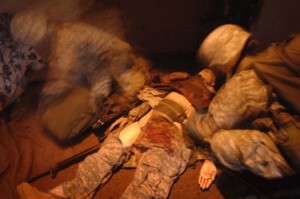Retooling to get Blood to the frontlines.
Retooling blood to front lines
Until now, getting blood to front-line casualties under fire has usually meant evacuating them by helicopter, under risky conditions, to a forward medical facility. But a new variant of a GPS-guided parachute system already used in Iraq and Afghanistan could soon save lives by dropping not bombs or bullets, but blood.
The Joint Precision Airdrop System has been used since at least 2004 by the Marine Corps, Army and Air Force to resupply besieged units isolated by enemy fire, distance or rugged terrain. But now, the Armed Services Blood Program has partnered with U.S. Joint Forces Command to retool the system to start delivering blood to front-line troops as early as 2011.
#1. Blood on the battlefield. The new sys tem means that with a C-130 or unmanned aerial vehicle trolling the skies over Afghanistan, gravely wounded Marines could have trans fused blood running through their veins in as little as 10 minutes.
With bleeding out still the No. 1 cause of death, that could mean a golden-hour reprieve for casualties who can’t be quickly evacuated.
“A medic might be traveling light and lean. Then something happens.
He calls in one of these deliveries and boom — a care package comes down and they have everything they need to treat a casualty,” said Air Force Maj. David Lincoln, an ASBP consultant on the project.
#2. How it works. The JPADS is a family of guided parachutes that can carry pay loads from 150 to 60,000 pounds. Once dropped, a small stabi lizing chute keeps the payload upright as it plummets at high speed. At a predetermined altitude, a parafoil deploys and a GPS-device steers supplies to an exact target.
#3. Scalability. In the past, large pal lets of up to 5,200 pounds of blood had to be dropped at large bases and then distributed by convoy or helicopter. The new system will use micro-light and ultralight variants of the JPADS to deliver small quan tities of blood so hospital corpsmen can treat Marines in the fight. New JPADS variants can deliver up to 150- and 699-pound payloads, respectively.
#4. Keeping troops out of harm’s way. With improvised explosive devices the greatest threat to ground troops in Afghanistan, the Marine Corps has been looking for ways to keep Marines and sailors off the road. The new system means convoys deliver ing blood and other supplies could sit out some resupply missions. The new system could also keep heli copter crews away from hot landing zones. The ability to make drops from thousands of feet means avia tors are kept out of the line of fire.
#5. Packaging. One of the biggest chal lenges in delivering blood, Lincoln said, is ensuring that it isn’t damaged by altitude, temperature or shock. His team is helping to develop specialized packaging that will keep blood cool, even in the inhospitable Afghan climate, and cushion it from the fall.
“We haven’t had any breakages or spills so far,” he said, adding that they have successfully dropped blood from 7,500 feet.
Those of you who have served on the frontline, how hard was it to get blood to your position? How close to the front was it before the patient saw the blood?
Leave a comment below.








